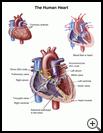
Ultrasound, Doppler
What is Doppler ultrasound?
Doppler ultrasound scanning is a safe and painless procedure used to look at the movement of blood inside the body. It uses high-frequency sound waves and their echoes to create video pictures or graphs of blood movement through the blood vessels. These pictures and graphs allow the provider to see the speed and direction of blood flow. Doppler ultrasound is used to look for clots, blockages, or abnormal areas in your blood vessels. It can also be used to guide your healthcare provider in treating an abnormality in your blood vessels.
How is Doppler ultrasound done?
Before the test:
Usually no preparation is necessary, unless your healthcare provider gives you special instructions.
During the test:
High-frequency sound waves pass through the body from a small device held against your skin. A gel or oil is put on your skin to improve the contact between your skin and the transducer. The transducer is connected to a computer with a display screen. As the sound waves pass through your body, they are reflected by the blood cells in the blood vessels and create echoes. The computer converts these echoes into pictures and graphs of the blood flow.
After the test:
- There is no special recovery needed after the Doppler ultrasound is done.
- You may stay in the hospital for a few hours or several days, depending on your condition and your test results.
- While you are in the hospital, you will be checked often by nursing staff.
- Your provider will use your test results to make a plan for your care.
What does the test result mean?
This test is only one part of a larger picture that includes your medical history and current health. Talk to your healthcare provider about your result and any follow up care you may need.
If your test results are not normal, ask your healthcare provider:
- If you need additional tests
- If you need treatment, and if so what your treatment plan choices are
Last modified: 2015-04-15
Last reviewed: 2015-10-07

